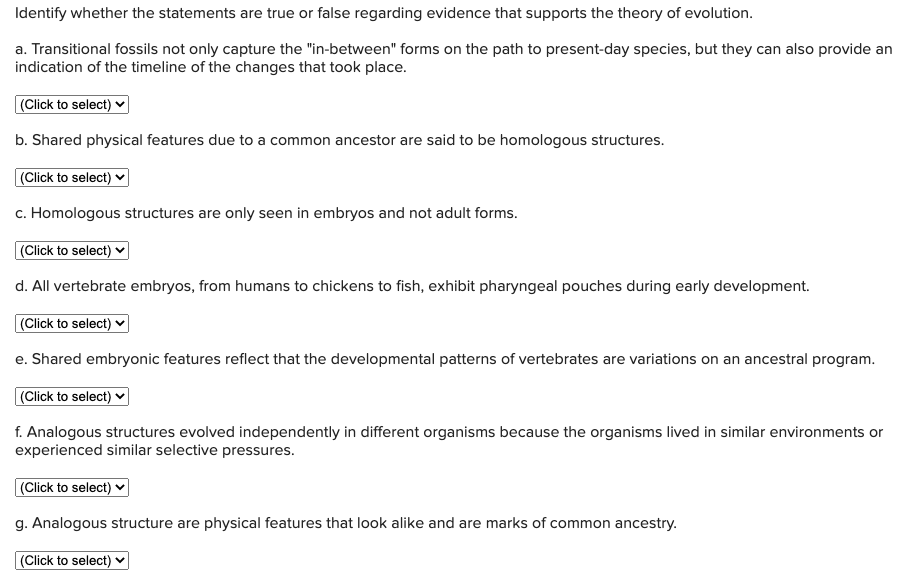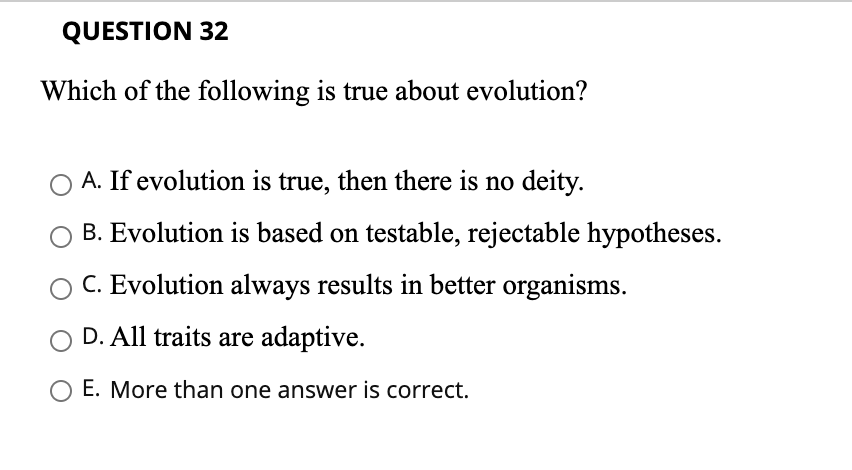Which Of The Following Statements Is True Regarding Evolution

The theory of evolution, a cornerstone of modern biology, continues to be a subject of both intense scientific investigation and public discourse. Misconceptions and misinterpretations about its core tenets persist, leading to confusion about what evolution *actually* states. Differentiating factual understanding from popular myths is crucial for informed decision-making in fields ranging from public health to environmental conservation.
This article aims to clarify common misunderstandings surrounding evolution and present accurate information based on scientific consensus. The goal is not to debate the validity of evolution, but to address specific statements about it and determine which are demonstrably true according to the established scientific framework. The focus will be on providing a factual overview supported by evidence from reputable sources.
Understanding Evolution: Core Principles
At its heart, evolution is the process by which populations of organisms change over generations. These changes are driven by various mechanisms, including natural selection, mutation, genetic drift, and gene flow. Understanding each is crucial to deciphering accurate from inaccurate claims.
Natural Selection: Survival of the Fittest?
Natural selection, often misconstrued as "survival of the fittest," is more accurately described as differential reproductive success. Organisms with traits that are better suited to their environment are more likely to survive and reproduce, passing on those advantageous traits to their offspring. This doesn't imply a constant struggle for survival or that the "fittest" is always the strongest or fastest.
It simply means those best adapted to their surroundings at a given time have a higher chance of contributing to the next generation's gene pool. The concept of "fitness" is therefore context-dependent and relates directly to reproductive success in a specific environment.
Mutation: The Engine of Novelty
Mutations are random changes in an organism's DNA. These can be harmful, neutral, or beneficial. Beneficial mutations, though rare, provide the raw material for evolutionary change by introducing new variations into a population.
Without mutation, there would be no new traits for natural selection to act upon. Mutations can arise spontaneously during DNA replication or be induced by environmental factors like radiation.
Genetic Drift and Gene Flow
Genetic drift refers to random fluctuations in gene frequencies within a population, especially pronounced in small populations. Gene flow is the movement of genes between populations, which can introduce new genetic variation or homogenize existing differences.
Both genetic drift and gene flow can significantly impact the evolutionary trajectory of a population, sometimes independently of natural selection.
Addressing Common Misconceptions
Several persistent misconceptions cloud public understanding of evolution. Addressing these is essential for clarifying which statements about evolution are accurate.
"Evolution is Just a Theory"
In scientific terms, a theory is a well-substantiated explanation of some aspect of the natural world that can incorporate facts, laws, inferences, and tested hypotheses. The theory of evolution is supported by a vast body of evidence from diverse fields, including paleontology, genetics, biogeography, and comparative anatomy.
Saying evolution is "just a theory" is like saying gravity is "just a theory." Both are explanations supported by overwhelming evidence and used to make accurate predictions.
"Humans Evolved From Monkeys"
This is a common but inaccurate simplification. Humans and modern apes share a common ancestor that lived millions of years ago. Evolution describes a branching tree of life, not a linear progression.
Humans did not evolve *from* monkeys, but rather share a relatively recent common ancestor with them. Both humans and monkeys have independently evolved along different evolutionary pathways since that divergence.
"Evolution Has a Goal"
Evolution is not a directed process with a predetermined endpoint. Natural selection acts on existing variation, favoring traits that are advantageous in a given environment at a specific time.
There's no inherent goal of "progress" or "improvement." Evolution is about adaptation to current conditions, which are constantly changing. This process may lead to increased complexity in some cases, but not always.
Which Statements About Evolution Are True?
Given the understanding of evolution's core principles and addressing common misconceptions, the following statements about evolution are demonstrably true, supported by scientific evidence:
1. Evolution is a change in the heritable characteristics of biological populations over successive generations. 2. Natural selection is a primary mechanism of evolution, favoring traits that increase survival and reproduction. 3. New genetic variation arises through mutation. 4. Humans share a common ancestor with other primates. 5. The theory of evolution is supported by a vast body of evidence from multiple scientific disciplines.
Conversely, statements suggesting evolution is "just a theory" in the colloquial sense, that humans evolved directly from modern monkeys, or that evolution has a predetermined goal, are demonstrably false based on the scientific understanding of evolution.
The Ongoing Evolution of Understanding
Our understanding of evolution continues to evolve as new research emerges. Advances in genomics, developmental biology, and other fields are constantly refining our understanding of the mechanisms and patterns of evolutionary change.
Ongoing research provides a richer and more nuanced understanding of the evolutionary history of life on Earth. It is crucial to remain open to new discoveries and interpretations while upholding the core principles that are supported by robust evidence.
The continuous advancement in evolutionary research is vital for addressing challenges in medicine, agriculture, and conservation. A deeper and more accurate understanding of evolution enables us to combat antibiotic resistance, develop new crop varieties, and protect biodiversity in a rapidly changing world. Therefore, differentiating fact from fiction is paramount in navigating the complexities of life and ensuring a sustainable future.




+Which+statement+regarding+evolution+is+false.jpg)





